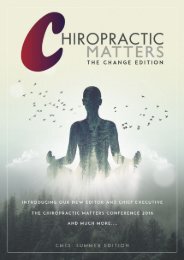aaCM 13 in design
You also want an ePaper? Increase the reach of your titles
YUMPU automatically turns print PDFs into web optimized ePapers that Google loves.
Neurology<br />
Shimizu Reflex<br />
Orthopaedic<br />
Thomas’ Test<br />
A muscle stretch reflex, <strong>in</strong>nervated by the high cervical<br />
sp<strong>in</strong>al cord.<br />
The reflex is performed by caudally tapp<strong>in</strong>g the tip of the<br />
sp<strong>in</strong>e of the scapula with a reflex hammer.<br />
Elevation of the scapula or abduction of the humerus is<br />
noted as a positive test<br />
Presence of a hyperactive reflex is considered diagnostic<br />
for craniovertebral or high cervical lesions. The major<br />
muscles participat<strong>in</strong>g <strong>in</strong> the reflex are considered to be the<br />
upper portion of the trapezius, the levator scapulae, and<br />
the deltoid.<br />
This is a test for fixed flexion deformities of the hip. It can also<br />
be used to assess muscle length of the rectus femoris, iliacus,<br />
tensor fascia lata and the iliotibial band.<br />
With the patient sup<strong>in</strong>e, the patient flexes the unaffected hip<br />
and knee towards the chest. grasp<strong>in</strong>g the knee with both hands.<br />
In a positive test ‘the affected hip will be drawn <strong>in</strong>to a degree of<br />
flexion br<strong>in</strong>g<strong>in</strong>g the thigh away from the couch’ (1) If the hip<br />
goes <strong>in</strong>to abduction more than flexion (known as the ‘J sign’ it<br />
can specifically <strong>in</strong>dicate shorten<strong>in</strong>g of the ITB (2) Fixed flexion<br />
deformities may be due to soft tissue (such as muscle) shorten<strong>in</strong>g,<br />
postural imbalances, fixed lumbar lordosis, significant<br />
posterior pelvic tilt, or may be secondary to pathologies such as<br />
osteoarthritis or fracture (1)<br />
Source:<br />
Shimizu T, Shimada H, Shirakura K (1993)<br />
Scapulohumeral reflex (Shimizu). Its cl<strong>in</strong>ical<br />
significance and test<strong>in</strong>g maneuver. Sp<strong>in</strong>e,<br />
18(15): 2182-90<br />
GCC Code<br />
THE<br />
REFRESHER<br />
PAGE<br />
Noth<strong>in</strong>g on this page<br />
should be new ...<br />
... but sometimes<br />
it is worth refresh<strong>in</strong>g...<br />
References:<br />
1) Hattam P, Smeatham A (2010) Special Tests <strong>in</strong><br />
Musculoskeletal Exam<strong>in</strong>ation; An evidence-based<br />
guide for cl<strong>in</strong>icians, Churchill Liv<strong>in</strong>gstone Elsevier,<br />
Pages 166-169<br />
2) Magee DJ (2008), Orthopaedic Physical<br />
Assessment, 5 edn., Saunders, Philadelphia.<br />
Hodgk<strong>in</strong>'s<br />
Lymphoma<br />
Source:<br />
http://www.gcc-uk.org/UserFiles/Docs/<br />
G20.006%20CofP_stage%203%20hyperl<strong>in</strong>ks%202708.pdf<br />
(Effective from June 30 2016)<br />
Source:<br />
Souza (2009) Differential Diagnosis and Management<br />
for the Chiropractor, 4 edn,Jones & Bartlett<br />
Publishers, USA, Page 976<br />
C4: Develop, apply and document a plan of care <strong>in</strong> full<br />
agreement with the patient. You must check the<br />
effectiveness of the care and keep the plan of care under<br />
review. A more formal reassessment of the effectiveness of<br />
the plan of care must be undertaken at <strong>in</strong>tervals<br />
that suit the patient and their needs. All subsequent<br />
modifications to the plan of care must be discussed and<br />
agreed with the patient and properly documented.<br />
F1: Explore care options, likely outcomes, risks and benefits<br />
with patients, encourag<strong>in</strong>g them to ask questions. You<br />
must answer fully and honestly, bear<strong>in</strong>g <strong>in</strong> m<strong>in</strong>d patients<br />
are unlikely to possess cl<strong>in</strong>ical knowledge.<br />
Professional<br />
Malignancy of the lymphatic system. 60% occur <strong>in</strong> children<br />
10-16 years old.<br />
Signs and symptoms <strong>in</strong>clude fatigue, fever, chronic cough,<br />
night sweats, weight loss, pa<strong>in</strong>less cervical or<br />
supraclavicular lymphadenopathy, pruritis and pa<strong>in</strong> worse<br />
with alcohol <strong>in</strong>gestion.' 50% have mediast<strong>in</strong>al mass on xray.<br />
CT scans, lymphangiography, bone marrow aspirate and<br />
biopsies determ<strong>in</strong>e spread of the disease. Presence of<br />
malignant Reed-Sternberg cells is diagnostic.<br />
Condition



